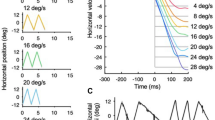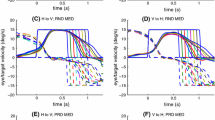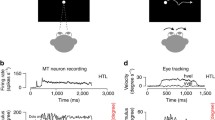Abstract
In this paper we test the proposition that in pursuit tracking, subjects compute stochastic (statistical) models of the temporal variations in position of the target and use these models to forecast target position for at least a response time interval into the future. A computer simulation of a human operator employing stochastic model prediction of target position is used to generate a synthetic pursuit tracking response signal. Actual pursuit tracking response signals are measured from 10 normal subjects using the same stimulus signal. Cross correlation and spectral analysis are employed to compute gain and phase frequency response characteristics for both synthetic and actual tracking data. The similarity of the gain and phase curves for synthetic and actual data provides compelling evidence in support of the proposition.
Similar content being viewed by others
References
Bendat JS, Piersol AG (1966) Measurement and analysis of random data. Wiley, New York
Box GEP, Jenkins GM (1976) Time series analysis: forecasting and control. Holden-Day, San Francisco
Curry RE, Gai EG (1976) Detection of random process failures by human operators. In: Sheridan TB, Johannsen G (eds) Monitoring behavior and supervisory control. Plenum Press, New York
Krendel ES, McRuer DT (1960) A servosystem approach to skill development. J Franklin Inst 269:24–42
Krendel ES, McRuer DT (1969) Psychological and physiological skill development — a control engineering model. Fourth Annual NASA-University Conference on Manual Control, NASA Spec Publ 192:275–288
McDonald JD, Bahill AT (1983) Zero-latency tracking of predictable targets by time-delay systems. Int J Control 38:881–893
McRuer DT, Jex HR (1967) A review of quasi-linear pilot models. IEEE Trans Hum Factors Electron HFE-8:231–249
McRuer DT, Krendel ES (1959) The human operator as a servo system element. J Franklin Inst 267:381–403, 511–536
McRuer DT, Krendel ES (1974) Mathematical models of human pilot behavior. NATO AGARDOgraph 188
Magdaleno RE, Jex HR, Johnson WA (1970) Tracking quasi-predictable displays. Subjective predictability gradations, pilot models for periodic and narrowband inputs. Fifth Annual NASA-University Conference on Manual Control. NASA Spec Publ 215:391–428
Marquardt DW (1963) An algorithm for least squares estimation of non-linear parameters. J Soc Ind Appl Math 11:431
Moray N (1976) Attention, control, and sampling behaviour. In: Sheridan TB, Johannsen G (eds) Monitoring behavior and supervisory control. Plenum Press, New York
Neilson PD, Neilson MD (1980) Influence of control-display compatibility on tracking performance. Q J Exp Psychol 32:125–135
Neilson PD, Neilson MD, O'Dwyer NJ (1985) Acquisition of motor skill in tracking tasks: Learning internal models. In: Russell DG, Abernethy B (eds) Motor memory and control. Human Performance Associates, Dunedin, pp 25–36
Neilson PD, Neilson MD, O'Dwyer NJ (1988) Intermittency and internal models: a theoretical account of human tracking behavior. Biol Cybern 58:101–112
Neilson PD, O'Dwyer NJ, Neilson MD (1987) Central processes underlying the movement disorders of cerebral palsy: a computational model of brain function. J Theor Biol (submitted for publication)
Pew RW (1974) Levels of analysis in motor control. Brain Res 71:393–400
Pew RW, Duffendack JC, Fensch LK (1967) Sine-wave tracking revisited. IEEE Trans Hum Factors Electron-8:130–134
Poulton EC (1952a) Perceptual anticipation in tracking with two-pointer and one-pointer displays. Br J Psychol 43:222–229
Poulton EC (1952b) The basis of perceptual anticipation in tracking. Br J Psychol 43:295–302
Poulton EC (1957) Learning the statistical properties of the input in pursuit tracking. J Exp Psychol 54:28–32
Poulton EC (1974) Tracking skill and manual control. Academic Press, New York
Poulton EC (1981) Human manual control. In: Brooks VB (ed) Handbook of physiology, Sect. 1: The nervous system, vol II, part 2. American Physiological Society, Bethesda, pp 1337–1390
Senders JW (1964) The human operator as a monitor and controller of multi-degree-of-freedom systems. IEEE Trans Hum Factors Electron-5:2–5
Smallwood RD (1967) Internal models of the human instrument monitor. IEEE Trans Hum Factors Electron-8:181–187
Stark L (1968) Neurological control systems. Studies in bioengineering. Plenum Press, New York
Stark L, Iida M, Willis PA (1961) Dynamic characteristics of the motor coordination system in man. Biophys J 1:279–300
Welford AT (1980) The single-channel hypothesis. In: Welford AT (ed) Reaction times. Academic Press, London, pp 215–252
Author information
Authors and Affiliations
Rights and permissions
About this article
Cite this article
Neilson, P.D., O'Dwyer, N.J. & Neilson, M.D. Stochastic prediction in pursuit tracking: An experimental test of adaptive model theory. Biol. Cybern. 58, 113–122 (1988). https://doi.org/10.1007/BF00364157
Received:
Accepted:
Issue Date:
DOI: https://doi.org/10.1007/BF00364157




